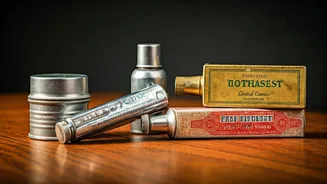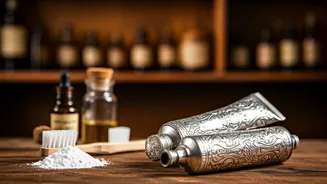Ancient Origins of Toothpaste
The desire for clean teeth dates back thousands of years. Around 3000 BCE, ancient Egyptians linked dental health and beauty, creating an early form of toothpaste
using ingredients like ground-up oxen hooves, pumice, and water. This paste, similar to what dentists still use for polishing enamel, demonstrated early efforts toward oral hygiene. Across various ancient societies, different methods and ingredients were employed. Indians utilized dantakastha, or teeth-cleaning twigs from neem, babul, or mango trees. The Chinese formulated powders mainly from fish bones, while the Greeks and Romans used a blend of crushed bones and oyster shells. The quest for minty-fresh breath dates back at least 5,000 years, showcasing the enduring human pursuit of oral cleanliness and pleasant breath.
Europe's Delayed Adoption
In pre-industrial Europe, the practice of daily tooth brushing wasn't widespread. Toothpaste and oral hygiene products were considered luxuries, only used before special occasions. At that time, dental care was primitive, with extractions by medicine men being the norm. The development of toothpaste and its application lagged behind other parts of the world. In the absence of anesthesia and modern dentistry, the focus on oral hygiene was less pronounced. Toothpaste, prepared at home by apothecaries, remained a specialized item, underscoring the lack of widespread adoption and understanding of the importance of regular oral care in Europe at that time.
The Packaging Revolution
A pivotal moment in the history of toothpaste occurred in 1892, thanks to an American dentist, Dr. Washington Sheffield. Inspired by how paint was packaged, he invented the toothpaste tube. This innovation dramatically improved the convenience and hygiene of the product. The introduction of the tube allowed for easier dispensing and prevented the spread of bacteria associated with communal jars. By 1896, Colgate, which had previously sold toothpaste in jars since 1873, switched to tubes, marking the beginning of the modern era of toothpaste use. This shift was key in popularizing toothpaste and improving oral hygiene practices globally.
Key Ingredient Innovations
The evolution of toothpaste formulas included several critical additions. Preservatives like benzoates were introduced to prevent bacterial growth within the tube, ensuring product safety. Fluoride was incorporated to strengthen tooth enamel and combat cavities, significantly improving dental health. Modern toothpaste formulations also added antibacterial agents to combat gum disease and pyrophosphates to reduce tartar buildup, enhancing overall oral hygiene. These ingredients improved the efficacy and extended the benefits of toothpaste, transforming it from a mere cleaning agent to a powerful tool in preventative dental care.
Foaming and Flavoring Agents
One of the key ingredients found in most toothpaste is sodium lauryl sulphate, the foaming agent. This chemical has a subtle impact on taste; it temporarily suppresses sweetness receptors and breaks down protective lipids on the tongue, allowing bitterness to dominate. This is why orange juice often tastes unpleasant immediately after brushing your teeth. Other elements like abrasives, humectants, thickeners, and flavouring agents play a crucial role. Abrasives such as silica or calcium carbonate help remove plaque and stains, constituting about one-third of the paste's weight. Detergents create foam and loosen debris, while binders keep the paste uniform.
The Striped Toothpaste Invention
In 1955, Leonard Marraffino of New York introduced a creative innovation: striped toothpaste. This was achieved by layering the colors within the tube. The ingenuity of the striped design illustrates how packaging and product design could introduce novelty to everyday consumer goods. The seemingly simple mechanism of layering the colors within the tube remains effective. Even when the tube is mashed and twisted, the stripes generally remain intact, thanks to the controlled viscosity. The innovation, though seemingly superficial, had a significant visual impact and became an enduring feature of the product.















